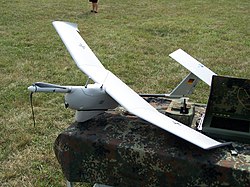EMT Aladin
| Aladdin | |
|---|---|

|
|
| Type: | Reconnaissance drone |
| Design country: | |
| Manufacturer: | |
| Commissioning: |
October 19, 2005 |
| Number of pieces: |
323 (as of June 2014) |

The Aladin is a reconnaissance drone from the German company EMT for immediate military reconnaissance in the immediate vicinity. The name Aladdin is an acronym their description and stands for a bbildende l uftgestützte A ufklärungs d Rohne i m N ächstbereich .
The starting point for the development of the program was an order for 115 drone systems by the German Armed Forces for the army reconnaissance troops in March 2005 . On October 19, 2005, the first serial system ALADIN was handed over to the armored troop school in Munster . By June 2014, a total of 323 reconnaissance drones had been delivered, of which 290 drones (145 systems) were in the Bundeswehr's “usable inventory” at that time.
system
The system is controlled remotely via the ground control station (BKS) using a built-in GPS receiver, generally program- controlled on a previously determined flight path. The user is able to influence the flight via the ground control station. The video data is transmitted in real time and saved on DV cassettes. The data transmission route determines the operational range, which can, however, be increased using a relay drone.
The entire system can be transported by a small group.
In the German army, every deployment system includes two aircraft, a weather station and a ground control station for mission planning and flight control.
Aircraft
The respective sensor payload is firmly integrated in the fuselage of the aircraft. Depending on the light conditions and intended use, different hulls are available for daylight (color images, black and white images at dusk) and night vision (infrared); these differ primarily in the sensor technology. To make it easier to find the aircraft after landing in the dark, an additional infrared LED is installed on the top of the night vision hulls.
The aircraft can be easily dismantled and reassembled without tools in order to simplify transport. It is ready for use within five minutes and is started by throwing it by hand or with the help of a rubber rope. The landing is done by bag landing.
Ground control station (BKS)
The BKS comprises the transmission and reception system, including the antenna mast, rod and panel antenna and the control unit (BG). The antenna mast has an antenna tracking aid.
The BKS has the ability to control the autonomous flight around terrain obstacles, can call up digital mission maps in 2D or 3D display and has the option of image evaluation and storage. The ground control station has a weight of 17 kg, uses the UHF band for transmission and the C band for reception . If the connection is lost (uplink), the aircraft automatically initiates an emergency procedure after ten seconds; To do this, Aladin follows the previously determined flight route and automatically performs a bag landing in the landing zone. If the GPS sensor fails, the Aladin automatically initiates a safety landing after 60 seconds.
The BG is used for flight planning, flight guidance and the presentation of the reconnaissance results. Information about the position and operating status of the aircraft is displayed to the operator in real time.
Technical specifications
Aircraft
| Parameter | Data |
|---|---|
| Type | unmanned small drone |
| Unit price (2012): | 53,000 euros |
| Length: | 1.57 m |
| Span: | 1.46 m |
| Altitude: | 30–200 m (above ground) |
| Takeoff weight: | 3.2 kg |
| Speed: | 45-90 km / h |
| Range: | 5 * - 15 km (* BW information; expandable) |
| Flight duration: | Depending on environmental influences, 60 minutes according to regulations |
| Power supply: | Lithium manganese battery 14.4 V, 3.2 Ah |
| drive | 1 × brushless DC motor up to 30 V, folding two-blade propeller |
The data are based on information provided by the manufacturer.
See also
literature
- Reinhard Scholzen : Army reconnaissance . Motorbuch-Verlag, Stuttgart 2012. ISBN 978-3-613-03408-2 .
Web links
Individual evidence
- ↑ Overview: Bundeswehr drones and drone losses. Press and Information Office in the Federal Ministry of Defense, August 20, 2014, accessed on April 9, 2015 .
- ↑ http://www.emt-penzberg.de/index.php?id=19 (link not available)